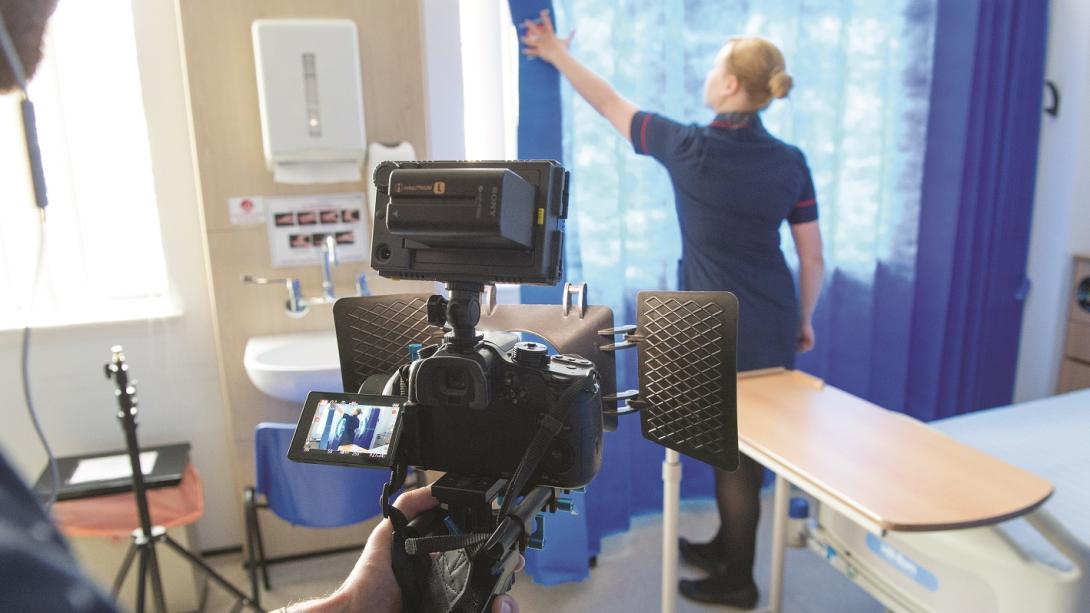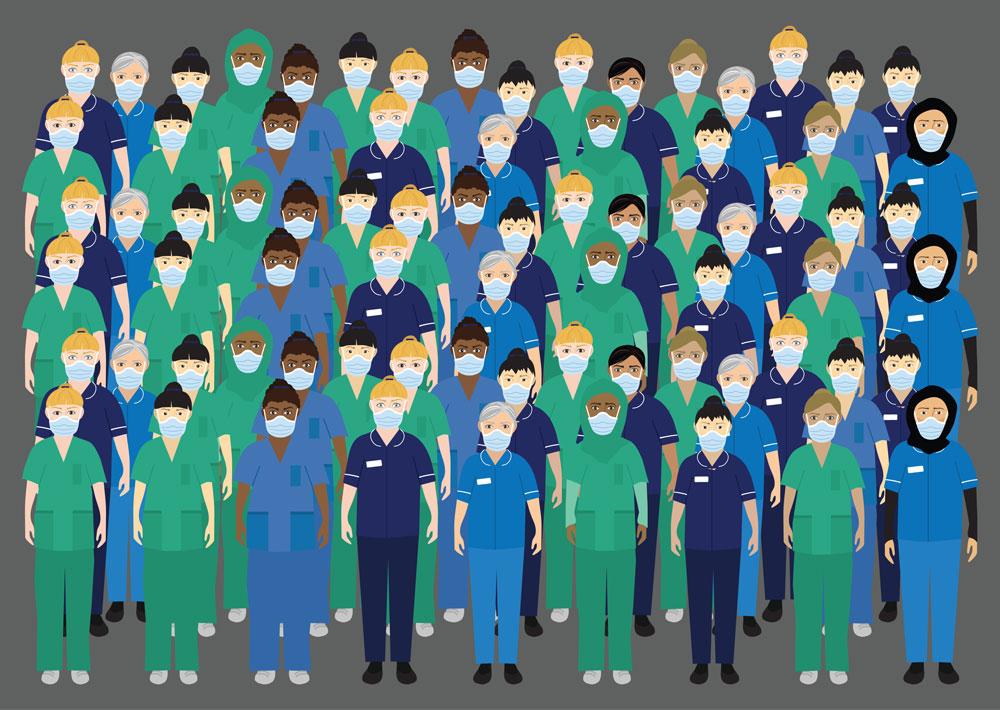Peter Riches, Digital Marketing Director at Midlands-based creative digital agency Clear, explains why a growing number of NHS trusts are turning to social media to ease their recruitment woes
Recruitment within the NHS is a bucket which leaks permanently; there is no easy way to fix the leak as staff will always retire, change profession, or relocate to another trust. And with strong patient/staff ratios guidelines to maintain, it would have a devastating impact on the UK to let the bucket run dry.
That’s why recruitment and retention is such a key focus. And yet still to this day, many trusts are relying on traditional methods to try and draw in staff. Pre-pandemic, this was already a huge concern for the NHS and now, as the UK starts to consider life after the Covid-19 crisis, it’s set to be an even bigger issue. Once the fantastic volunteers and retired staff who have lined up to assist the health system during the height of the coronavirus spread have returned to their everyday lives, the problem will need to be tackled head-on.
A huge part of the problem is the sheer scale of recruitment needed – this isn’t about taking on a handful of new trainees each year like in many smaller organisations. It’s one of the biggest employers in the world with well over a million staff across a huge range of clinical and non-clinical roles. Data showed more than 100,000 vacancies in 2019 and it’s predicted that in a decade, the staff shortfall will have reached 250,000.
At the same time, demand for services is rising exponentially with factors such as the ageing population, increasing numbers of patients needing mental health support, and the impact of soaring obesity-related health complaints bringing an already under-funded NHS to ‘breaking point’ – the term used by the British Medical Association three years ago, well before the Covid-19 pandemic.
Add to that a 30 per cent decrease in applications for nursing degrees after bursaries were cut, costs of locum and agency staff rising, the demand for more flexible working can prove tricky for a sector which cannot simply offer home-working as a solution. And with widespread media coverage of funding issues playing its part in detracting potential NHS recruits - and you have a very real problem.
New methods of working
But there is a solution: while adopting new ways of recruiting isn’t going to be an overnight fix, it can prove hugely successful. That might be easy for us to claim as a creative agency which offers online marketing and recruitment strategies, creates websites that form the hub of communication and social media campaigns to help recruit. But that’s why we have shared a relevant case study to support our activity with facts and figures.
Initially, Shrewsbury and Telford Hospitals NHS Trust (SATH) contacted us to see whether we could trial a new digital strategy for three months. They wanted to ‘invest to save’ by scaling back their traditional advertising, where possible and invest into an online campaign to see if this would save them time, resources and of course money in the long-term. Return on investment was key to the success.
We reviewed existing strategy and noted their recruitment pages were located within their main website along with information about facilities at their hospital which would ordinarily be accessed by visitors; and the recruitment section itself was very copy-heavy. We also noted that, whilst they were using social media, these messages were generally getting lost among too much ‘noise’: press releases, visitor announcements, fundraising campaigns, and hundreds of other posts.

From experience we knew that while recruits would want to know about specific career opportunities within the two hospitals, they would also want to know what Shropshire, as a location, could offer them. When people start a new job, it’s far more than just ‘the job’, they do so because they feel comfortable with what the area offers. Are they happy to send their children to the schools in the local area? Is there lots to do and explore? Plenty of facilities nearby? Does the lifestyle fit in with what they ultimately desire? Are they inspired? But many of these ‘holistic’ factors are often ignored in job ads.
We focused on people’s aspirations and emotions and created the #BelongtoSomething campaign. Phrases such as Belong to Something - Scenic, Belong to Something - Peaceful, Belong to Something - Exciting were used alongside images and footage of real Shropshire NHS staff and interesting locations and attractions within the county; a dedicated portal with a separate domain name - https://www.jobs.sath.nhs.uk/ was created to advertise available jobs; and social media was integrated into an online hub too.
This not only proved impactful for potential recruits, it also saved time and admin resources by automatically linking and uploading positions on NHS Jobs to the Shropshire portal website, social media and third-party recruitment sites such as indeed.com
The messaging and imagery used was consistent across the entire spectrum of the campaign, essentially creating a brand which attracted and engaged exactly the sort of people the trust was looking to recruit. The campaign incorporated everything from photography and videography, to portal and mobile-friendly site development, SEO (search engine optimisation), social media, data capture via a branded newsletter sign up form, right through to traditional adverts, exhibition materials and giveaways.. This meant that the campaign created a ‘halo’ effect and the same message was consistent throughout all communication - it covered everything the Trust needed - all HR had to do was provide information about their vacancies.
And did it work? The trust certainly felt so: having recruited ten nurses and two doctors during the initial trial, they asked us to continue working on the campaign for another three months, then another six months, then a further two years – after which our account manager joined the SATH team as an internal member to take over the handling of the social media and online recruitment.
For those who like statistics, prior to passing the project back to the NHS to manage in house this is what we helped achieve: over 12million digital impressions since the start of the campaign; 1,279,279 website sessions; 547,974 visits to our recruitment hub; 12,466 collected email addresses for job alerts; and 13,797 Facebook followers, a number that is still growing.
Now, four years down the line, many of our digital and social media strategies are still producing results.
In addition to the online recruitment campaign we also worked with SATH on a number of wider strategies such as their creative ads, branding, a nurse bank campaign, staff induction booklet and their 2019-2024 Sustainability and Transformation Partnership document.
While the number of staff successfully employed is a very clear aim of any recruitment drive, the trust has been able to demonstrate positive impact across a number of other areas – such as employee retention – the messaging worked: staff were so engaged with the campaign that it’s now used as a morale booster to instil loyalty and ensure staff retention; in fact, you’ll still see the #BelongtoSomething imagery and slogan displayed widely across staff areas in both hospitals.
The question is – could this strategy work across other NHS regions? We believe it can.

While running a successful campaign is great for us as an agency, it needs to work well beyond the last day of our involvement – the fact SATH now has a really holistic way of looking at their recruitment policy (both the messaging they use as a whole, and what they and Shropshire as a location have to offer recruits) means they are set up professionally to continue using online and social media platforms as a key component of their campaigns even as the digital world continues to evolve and grow.
A little over 15 years ago, when Facebook was in its infancy, the more savvy among internet users might have predicted that online job hunting was the future. But the future is now – and what better time for the NHS to invest to save, create a consistent recruitment brand and start filling up that leaky bucket.
For further information, please contact peter@cleardesign.co.uk





